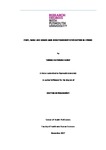Foot, ankle and lower limb somatosensory dysfunction in stroke
| dc.contributor.supervisor | Marsden, Jonathan | |
| dc.contributor.author | Gorst, Terry | |
| dc.contributor.other | Faculty of Health | en_US |
| dc.date.accessioned | 2017-12-06T14:38:01Z | |
| dc.date.issued | 2017 | |
| dc.identifier | 324555 | en_US |
| dc.identifier.uri | http://hdl.handle.net/10026.1/10385 | |
| dc.description.abstract |
The extent to which sensory impairments in the foot, ankle and lower limb persist into the chronic phase of stroke is unclear. Furthermore, the extent to which these impairments influence walking, balance and falls is not well understood. This thesis investigated the prevalence, functional importance and measurement of lower limb somatosensory impairments in ambulatory people with chronic stroke. Methods This thesis comprised three studies: the first, a qualitative investigation, explored the views and experiences of people with chronic stroke (n=13). This led to the second study: a cross sectional observational study in which the prevalence, distribution and functional relevance of lower limb sensory impairments were investigated in chronic stroke participants (n=180) and healthy controls (n=46). The final study, informed by the findings from the first two studies, a “synthesis” review of current sensory measures and patient and carer involvement, developed and evaluated three novel, functionally oriented measures of lower limb somatosensory discrimination in chronic stroke (n=32) and healthy controls (n=32). Results People with stroke felt problems with foot, ankle and lower limb sensation affected their walking, balance and contributed to falls. Furthermore, sensory impairments in the lower limb are prevalent with up to 59% of chronic stroke survivors having a deficit of one or more somatosensory modality. Despite this, weak associations between traditional measures of tactile and proprioceptive sensation and walking, balance and falls were demonstrated. Novel, functionally oriented measures of tactile and proprioceptive discrimination were developed and evaluated. These measures were reliable and valid, showing greater sensitivity to predicting the presence of sensory impairments and had stronger associations with functional measures than traditional sensory tests. Conclusions This thesis has provided a comprehensive picture of lower limb somatosensory dysfunction in chronic stroke survivors. Sensory impairments persist into the chronic phase of stroke in the majority of stroke survivors. The extent to which such impairments influence functional ability warrants further investigation. The use of functionally oriented measures that assess higher-level somatosensation is encouraged. | en_US |
| dc.description.sponsorship | Chartered Society of Physiotherapy | en_US |
| dc.description.sponsorship | Dr William Scholl Podiatric Research and Development Fund | en_US |
| dc.language.iso | en | |
| dc.publisher | University of Plymouth | |
| dc.subject | Ankle | |
| dc.subject | Lower limb sensation | |
| dc.subject | Stroke | |
| dc.subject | Sensory impairment | |
| dc.subject | Foot | en_US |
| dc.subject.classification | PhD | en_US |
| dc.title | Foot, ankle and lower limb somatosensory dysfunction in stroke | en_US |
| dc.type | Thesis | |
| plymouth.version | publishable | en_US |
| dc.identifier.doi | http://dx.doi.org/10.24382/591 | |
| dc.rights.embargodate | 2018-12-06T14:38:01Z | |
| dc.rights.embargoperiod | 12 months | en_US |
| dc.type.qualification | Doctorate | en_US |
| rioxxterms.version | NA |
Files in this item
This item appears in the following Collection(s)
-
01 Research Theses Main Collection
Research Theses Main


